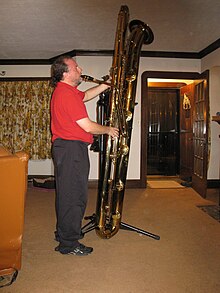Subcontrabass saxophone

 | |
| Woodwind instrument | |
|---|---|
| Classification | Single-reed |
| Hornbostel–Sachs classification | 422.212-71 (Single-reed aerophone with keys) |
| Inventor(s) | Adolphe Sax |
| Developed | Conceived as part of Sax's 1846 patent; first playable instrument built by J'Élle Stainer in 2010 |
| Playing range | |
 | |
| Related instruments | |
| Sizes: Orchestral saxophones: Specialty saxophones: | |
| Musicians | |
| |
| Builders | |
| |
The subcontrabass saxophone is the largest of the family of saxophones that Adolphe Sax described in his 1846 patent. He called it the saxophone bourdon, named after the very low-pitched 32′ bourdon pedal stop on large pipe organs. Although Sax planned to build one, the first playable instrument was only built in 2010. It is a transposing instrument pitched in B♭ one octave below the bass saxophone, two octaves below the tenor, and three octaves and a major second below its written pitch.[1]
History
[edit]Although described in Adolphe Sax's patent in 1846, a practical, playable subcontrabass saxophone did not exist until the 21st century.[2] An oversized saxophone that might have qualified was built as a prop circa 1965; it could produce tones, but its non-functional keywork required assistants to manually open and close the pads, and it was reportedly incapable of playing a simple scale.[3]
The tubax was developed in two sizes in 1999 by German instrument manufacturer Benedikt Eppelsheim, the lower of which, pitched in B♭, he describes as a "subcontrabass saxophone".[4] This instrument provides the same pitch range as the saxophone bourdon would have, while the smaller tubax in E♭ covers the range of the contrabass saxophone. Compared to a regular saxophone, the tubax has a narrower bore and uses a smaller reed.[5]
In the 2000s, contrabass and subcontrabass saxophones became popular in church orchestras in Brazil, and are made by Brazilian instrument manufacturers J'Élle Stainer and Galassine. J'Élle Stainer produced a working compact subcontrabass saxophone in 2010, which was shown that year at Expomusic.[1][6] In September 2012, Eppelsheim built the first full-size subcontrabass saxophone in B♭ (distinct from his B♭ tubax).[7] In July 2013, J'Élle Stainer completed a full-size subcontrabass saxophone.[8][9] It stands 2.74 metres (9 ft 0 in) high and weighs 28.6 kilograms (63 lb).[10] In Brazil, at least one octocontrabass saxophone, built in E♭ an octave below the contrabass, has been made.[11][citation needed]
Repertoire
[edit]There is no historical classical music or jazz repertoire specifically scored for a subcontrabass saxophone, since playable instruments have only existed since 2010. Two works first performed in 2022, Slovenian composer Igor Krivokapič's Symphony No. 5 and Colores by Belgian composer Jan Van der Roost, both feature the instrument.[12] Low-pitched saxophones in general have become popular in Brazil, particularly in the large church orchestras of the Christian Congregation in Brazil that accompany hymns.
See also
[edit]References
[edit]- ^ a b Berni, Attilio (21 February 2013). "J'Elle Stainer Double Bb Sub-contrabass Saxophone". saxophone.org. Archived from the original on 22 November 2022. Retrieved 22 November 2022.
- ^ Cottrell 2012, p. 53.
- ^ Green, Grant D. (2002). "Subcontrabass Saxophones (?)". Contrabass Compendium. Archived from the original on 27 September 2021. Retrieved 17 March 2007.
- ^ "Tubax (B♭)". Munich, Germany: Benedikt Eppelsheim Wind Instruments. Archived from the original on 6 November 2022. Retrieved 6 November 2022.
- ^ Cohen, Paul (September 2000). "Redefining the saxophone, Soprillo and Tubax: new saxophones for a new millennium". Saxophone Journal. 25 (1). Needham, MA: Dorn Publications: 8–10. ISSN 0276-4768.
- ^ "Compact Subcontrabass". J'Élle Stainer Extreme Saxophones. Archived from the original on 21 November 2022. Retrieved 22 November 2022.
- ^ "Custom made". Munich, Germany: Benedikt Eppelsheim Wind Instruments. Archived from the original on 29 November 2022. Retrieved 22 November 2022.
- ^ "GWR Subcontrabass". J'Élle Stainer Extreme Saxophones. Archived from the original on 6 November 2022. Retrieved 6 November 2022.
- ^ Berni, Attilio (saxophone); Romeo, Alfredo (drums); Antinozzi, Christian (bass); Crispolti, Alessandro (piano) (27 January 2021) [recorded 18 October 2020]. Sub contrabbasso J'Elle Stainer Eppelsheim soprillo (video). Maccarese, Italy: Museo del Saxofono. Retrieved 22 November 2022 – via YouTube.
- ^ "Largest saxophone - playable by one person". Guinness World Records. 3 August 2013. Archived from the original on 21 November 2022. Retrieved 22 November 2022.
- ^ Valadares, Bruno (28 May 2024). "OctaContraBaixo - Ensaio local em Jordanópolis, SBC, SP". Retrieved 5 June 2024 – via Instagram.
- ^ "7 Trumpets of the Apocalypse". Ljubljana: Cankarjev dom. 13 September 2022. Retrieved 23 June 2024.
Bibliography
[edit]- Cottrell, Stephen (2012). The Saxophone. Yale Musical Instrument Series. New Haven: Yale University Press. ISBN 978-0-300100-41-9. LCCN 2012028346. OCLC 844030644. OL 25377233M. Wikidata Q113952716.
External links
[edit]- Attilio Berni in Back Home Again Indiana (YouTube) solos on the subcontabass and soprillo (Saxophone Museum, Maccarese, 2020)
- MP3 sound recording of the first movement of "Duet for Basses" by Walter Hartley, played as a B♭ Tubax duet (one instrument, overdubbed), performed by Jay C. Easton